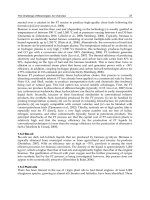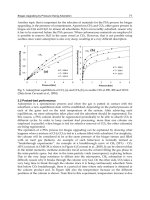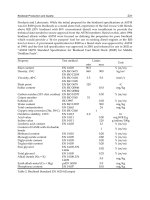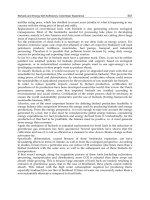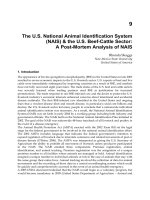Composites Manufacturing - Materials, Product, and Process Engineering Part 7 potx
Bạn đang xem bản rút gọn của tài liệu. Xem và tải ngay bản đầy đủ của tài liệu tại đây (60.5 KB, 2 trang )
© 2002 by CRC Press LLC
is not as crucial, spray-up is the more suitable option. Bathtubs, swimming
pools, boat hulls, storage tanks, duct and air handling equipment, and fur-
niture components such as seatings are some of the commercial uses of this
process.
6.8.3.2 Basic Raw Materials
The reinforcement material for this process is glass fiber rovings, which are
chopped to a length of 10 to 40 mm and then applied on the mold. For
improved mechanical properties, a combination of fabric layers and chopped
fiber layers is used. The most common material type is E-glass, but carbon
and Kevlar rovings can also be used. Continuous strand mat, fabric, and
various types of core materials are embedded by hand whenever required.
The weight fraction of reinforcement in this process is typically 20 to 40%
of the total weight of the part.
The most common resin system used for the spray-up process is general-
purpose or DCDP polyester. Isophthalic polyester and vinylesters are also
used in this process. Fast-reacting resins with a pot life of 30 to 40 min are
typically used. The resin often contains a significant amount of filler. The
most common fillers are calcium carbonate and aluminum trihydrate mate-
rials. In filled resin systems, fillers replace some of the reinforcements; 5 to
25% filler is used by weight.
6.8.3.3 Tooling Requirements
The mold used in this process is identical to that used in the wet lay-up
process. Male and female molds are used, depending on the application.
Tubs and showers utilize male molds, whereas boat hulls and decks utilize
female molds. To make bathtubs, FRP molds are used. The method used to
make the mold is described in Section 6.4.3.
6.8.3.4 Making of the Part
The processing steps used in the spray-up process are very similar to those
in the wet lay-up process. In this process, the release agent is first applied
to the mold and then a layer of gel coat is applied. The gel coat is left for
2 hr, until it hardens. Once the gel coat hardens, a spraygun is used to deposit
the fiber resin mixture onto the surface of the mold. The spraygun chops the
incoming continuous rovings (one or more rovings) to a predetermined
length and impels it through the resin/catalyst mixture as shown in
Figure 6.27. Figure 6.28 shows the application of chopped fibers and resin
by a robot. Resin/catalyst mixing can take place inside the gun (gun mixing)
or just in front of the gun. Gun mixing provides thorough mixing of resin
and catalyst inside the gun and is preferred to minimize the health hazard
concerns of the operator. In the other type, the catalyst is sprayed through
two side nozzles into the resin envelope. Airless sprayguns are becoming
© 2002 by CRC Press LLC
is not as crucial, spray-up is the more suitable option. Bathtubs, swimming
pools, boat hulls, storage tanks, duct and air handling equipment, and fur-
niture components such as seatings are some of the commercial uses of this
process.
6.8.3.2 Basic Raw Materials
The reinforcement material for this process is glass fiber rovings, which are
chopped to a length of 10 to 40 mm and then applied on the mold. For
improved mechanical properties, a combination of fabric layers and chopped
fiber layers is used. The most common material type is E-glass, but carbon
and Kevlar rovings can also be used. Continuous strand mat, fabric, and
various types of core materials are embedded by hand whenever required.
The weight fraction of reinforcement in this process is typically 20 to 40%
of the total weight of the part.
The most common resin system used for the spray-up process is general-
purpose or DCDP polyester. Isophthalic polyester and vinylesters are also
used in this process. Fast-reacting resins with a pot life of 30 to 40 min are
typically used. The resin often contains a significant amount of filler. The
most common fillers are calcium carbonate and aluminum trihydrate mate-
rials. In filled resin systems, fillers replace some of the reinforcements; 5 to
25% filler is used by weight.
6.8.3.3 Tooling Requirements
The mold used in this process is identical to that used in the wet lay-up
process. Male and female molds are used, depending on the application.
Tubs and showers utilize male molds, whereas boat hulls and decks utilize
female molds. To make bathtubs, FRP molds are used. The method used to
make the mold is described in Section 6.4.3.
6.8.3.4 Making of the Part
The processing steps used in the spray-up process are very similar to those
in the wet lay-up process. In this process, the release agent is first applied
to the mold and then a layer of gel coat is applied. The gel coat is left for
2 hr, until it hardens. Once the gel coat hardens, a spraygun is used to deposit
the fiber resin mixture onto the surface of the mold. The spraygun chops the
incoming continuous rovings (one or more rovings) to a predetermined
length and impels it through the resin/catalyst mixture as shown in
Figure 6.27. Figure 6.28 shows the application of chopped fibers and resin
by a robot. Resin/catalyst mixing can take place inside the gun (gun mixing)
or just in front of the gun. Gun mixing provides thorough mixing of resin
and catalyst inside the gun and is preferred to minimize the health hazard
concerns of the operator. In the other type, the catalyst is sprayed through
two side nozzles into the resin envelope. Airless sprayguns are becoming




